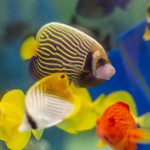 On March 15, the Tennessee Aquarium will celebrate the opening of Island Life, a diverse new gallery that challenges how “islands” are defined while taking guests on a globe-trotting exploration of isolated ecosystems above and below the water.
On March 15, the Tennessee Aquarium will celebrate the opening of Island Life, a diverse new gallery that challenges how “islands” are defined while taking guests on a globe-trotting exploration of isolated ecosystems above and below the water.
“We’re excited for guests to experience these new exhibits. They’ll feel like world travelers while seeing some pretty amazing animals,” said Thom Demas, the Aquarium’s director of aquatic collections and life support systems. “I think visitors will be amazed by Flashlight Fish, and will love seeing many other species we haven’t exhibited previously. Islands are remarkably diverse locations, and in this gallery, we’re able to tell quite a few of these stories of biodiversity.”
A journey through Island Life will whisk guests around the world, from the frigid waters of the Pacific Northwest to the tropical seas off Southeast Asia to the teeming wilds of Madagascar. Some of the stops along the way include:
- Vancouver Island. Recreating the waters off the rocky shores of Canada’s West Coast, Vancouver Island features a wide variety of colorful anemones, urchins, sea stars and other marine life. This habitat is Island Life’s piece de resistance, a massive, dynamic display with artificially generated waves that rush along 20 feet of sinuously curved acrylic before crashing against an upright viewing window.
- Indo-Pacific Reef. In the mostly barren expanse of the ocean floor, reefs are like underwater islands, oases of life and refuge to a stunning variety of animals. In Island Life, the Indo-Pacific Reef tank highlights a huge variety of aquatic life found off the coast of Southeast Asia in a region known as the Coral Triangle. This expanse of ocean is home to nearly 600 species of reef-building corals and more than 2,000 kinds of fish. This towering, eight-foot-tall display is the second-largest exhibit in the Ocean Journey building. Here, guests will see a bustling community comprising more than 30 species of vibrant reef-dwellers, including Polleni Groupers, Kole Tangs, Picasso Triggers and Guinea Fowl Pufferfish.
- Cave of the Flashlight Fish. Inside this dim, mirror-filled room, the darkness will glow with flashes of light courtesy of hundreds of Split Fin Flashlight Fish. This deep-dwelling fish generates light through pockets of glowing bacteria housed in a pouch under its eyes. During the day, this fish resides in the darker depths of the ocean before migrating upwards at night along a kind of vertical island to feed in shallower water. This habitat features one of the largest schools ever exhibited of this bioluminescent species.
- Clownfish and Anemones. Thanks to the Pixar classic Finding Nemo, most people are familiar with the symbiotic relationship of this oceanic Odd Couple. In Island Life, this exhibit will show off how colorful Pink Skunk and False Percula Clownfish have adapted to seek shelter within the venomous, stinging tentacles of Bubbletip Anemones, which act as a kind of living “island.”
- Marvelous Madagascar. At more than 225,000 square miles, Madagascar is 40 percent larger than California and ranks as the world’s fourth largest island. Because its species have developed in isolation for millions of years, scientists estimate that about 75 percent of this African island’s plants and animals can be found nowhere else on Earth. In a pair of Island Life exhibits sponsored by Unum, guests will become familiar with a wide variety of Malagasy reptiles and amphibians, including riotously colorful Panther Chameleons, nimble Madagascar Giant Day Geckos, poisonous Mantella Frogs and critically endangered Radiated Tortoises.
Visitors will be led on their exploration of this densely packed space by a scaly guide, Leon the Chameleon. Throughout the gallery, Leon will appear on graphics and interactive elements sponsored by Unum to pose questions that make guests — especially younger ones — question their understanding of islands and the special adaptations of the animals on display.
“I want people to come away with a whole new appreciation of islands and to expand their thought about islands and the animals that live on them,” says Jeff Worley, the Aquarium’s exhibit designer. “If we can start that when someone is three years old, then by the time they’re adults, they’ll be thinking differently about the world and maybe acting differently, too.”
Throughout Island Life, guests can deepen their experience through fun activities that bring to life many of the species’ unique adaptations via multimedia and physical engagement.
Visitors can speed up or slow down video footage of a Chameleon’s tongue in mid-flight, do their best Clownfish impression by weaving through oversized anemone tentacles, light up touch-sensitive Flashlight Fish and snap turtle-y awesome selfies atop an enormous bronze sculpture of a Galapagos Tortoise sponsored by Tennessee American Water.
These many interactive elements combined with the ever-changing, always-photo-worthy interaction of the animals mean return visits to Island Life are sure to offer up new memorable moments and bring to light overlooked details. Yearlong family memberships to the Aquarium include unlimited daily visits for two adults and five children and can be purchased at community.tnaqua.org/join.
After visiting Island Life, the fun continues with a pair of stunning giant-screen films at the Tennessee Aquarium IMAX 3D Theater. Showing through May 24, Oceans: Our Blue Planet features breathtaking footage displaying the amazing diversity and stunning beauty of the planet’s largest, least-explored ecosystem. All summer long, guests can join narrator Kristen Bell (Frozen, The Good Place) to catch up on un-bear-ably cute Giant Panda cubs being trained for reintroduction to the wild in Pandas 3D. Tickets, showtimes and additional information available at tnaqua.org/imax.
















